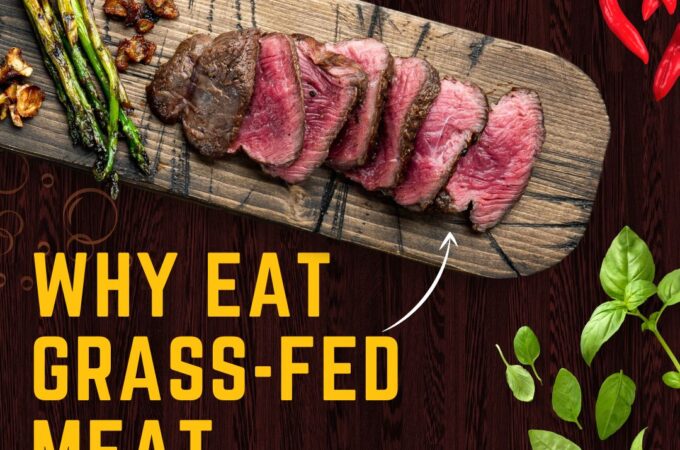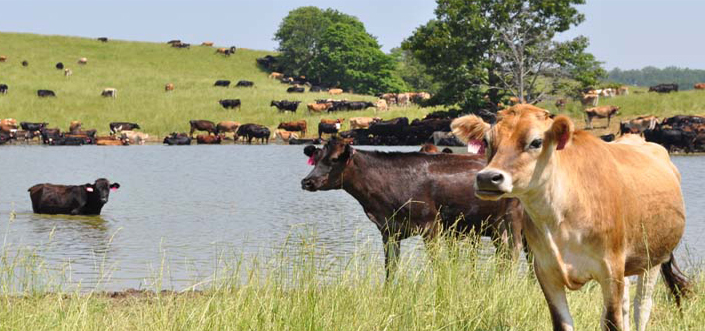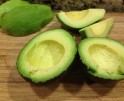
Why Eat Grass-Fed Meat
Do you know where your meat is coming from and how the animals were raised?
90% of cattle in this country end up in a commercial feed lot.
Meat from the grocery store is usually from cattle that are:
- overdosed with hormones, antibiotics and steroids
- fed an unnatural diet high in grains
Grass-fed beef cattle graze freely throughout their lives, eating the all-grass diet nature intended, to become robust and healthy.
- No hormones, no antibiotics, no steroids
- 1/3 less calories
- More nutrients
- Better omega 6:3 ratio
- Not finished on grain to fatten them up
More Vitamins and Nutrients
- Grass-fed beef has more B vitamins, Vitamin E and zinc (aid immunity)
- It has more selenium (needed for a healthy immune system)
- It has more carotenoids (4 times more than grain-fed. For eye health).
Omega-3 Fatty Acids
- Grass-fed cattle have the right ratio of omega 6:3, which is 2:1.
- Grain-fed cattle have very high levels of omega 6 with a ratio of 20:1
- If the cattle is grass-fed but finished on grain (to increase the weight) then this can undo the omega 6:3 ratios and CLA values in 30 days.
CLA
Grass-fed beef contains 2-4 times more CLA, conjugated linoleic acid.
- Helps you lose weight
- Helps the body put on lean muscle and reduce fat
- Known cancer fighter
- Reduces risk of heart disease
- Effective against diabetes
Research shows that a diet rich in CLA can help reduce a person’s risk of cancer, atherosclerosis, and diabetes.
Conjugated linoleic acid (CLA) is fatty acid that is produced naturally in the bodies of grass-fed animals and is found in their meat and milk.
Grass-fed cattle are likely to have two to three times the amount of CLA as grain-fed animals, and this nutritional value is passed on to you when you eat grass-fed meat.
Carol Lorenzen, PhD, who teaches “Principle of Meat Science” and “Meat Investigations” at the University of Missouri, says CLA is abundant in grass-fed beef.
“Because of the grass, there are higher levels of certain fatty acids as opposed to grain fed beef. Some studies show that fatty acids like CLA reduce weight and aid in prevention of heart disease,” says Lorenzen.
Al Sears, MD wrote:
The meat from animals raised on grass has three distinct advantages over grain-fed meat in addition to the benefits of it having more B vitamins, vitamin E and zinc, which all aid your immunity:
- CLA – Grass-fed beef has two to five times more CLA than the grain-fed variety.(2) CLA is conjugated linoleic acid, a newly discovered “good fat” that does two things for you. First, it helps offset the effects of antibiotics in your food.(3) But it also helps reduce your total body fat.
- Selenium – A study from the University of Nebraska found that grass-fed buffalo had four times the selenium of grain-fed buffalo. Why is selenium important? Because selenium deficiency suppresses your immune system, interfering with its ability to fight infection and lowering your resistance to disease. And you won’t get enough from grain-fed animals because they get it from eating grass.
- Carotenoids – You don’t have to eat carrots all day to get enough of this nutrient that promotes eye and macular health. Grass-fed beef has up to four times more beta-carotene than grain-fed beef.
Look for grass-fed, pasture-raised meats from a local farmer, farmers market or on-line resource.
Recommended
-
Turmeric BenefitsJanuary 6th, 2024
-
Chia Super Food for Energy, Weight Loss & MoreAugust 8th, 2023
-
How to Freeze AvocadosJune 8th, 2023
-
How to Freeze Coconut MilkJune 1st, 2023










